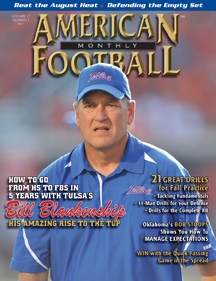Article CategoriesAFM Magazine
|
Defending the Empty Setby: Christian GuentherDefensive Coordinator Southwest Minnesota State University © More from this issue As the spread offense has become more popular, we are starting to see more teams utilize empty backfield sets. What has been the most difficult for our defense has been an offense that will stay in a traditional personnel grouping and then align in an empty set. We are a pressure defense at Southwest Minnesota State University that has to react to this type of formation through checks in our defense. Only one mistake can lead to a score or big play that could make the difference in a game. For this reason, we want to ensure that our defense is well-prepared for this set. The steps that we follow make sure that we are prepared to adjust and still have the opportunity to be aggressive on defense rather than reactive to the offense. The first steps in preparation are to identify the type of empty set our opponent will utilize an....The full article can only be seen by subscribers.
|
|
|||||||
| HOME |
MAGAZINE |
SUBSCRIBE | ONLINE COLUMNISTS | COACHING VIDEOS |
Copyright 2025, AmericanFootballMonthly.com
All Rights Reserved





